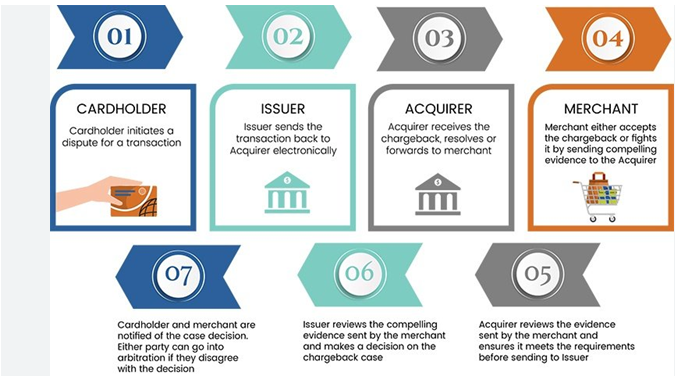Understanding Chargebacks
Chargebacks were established primarily to safeguard consumers' interests and rights in transactions involving credit or debit cards. These mechanisms were implemented as a form of consumer protection, aiming to provide a safety net for cardholders in case of unauthorised transactions, fraud, or disputes with merchants. Chargebacks offer consumers a means to dispute transactions directly with their card issuer, allowing them to seek refunds or to rectify unauthorised charges, ensuring a level of confidence and security in their financial dealings. While chargebacks serve to protect customers from potentially fraudulent activities or unsatisfactory purchases, they are not primarily designed to benefit merchants. Instead, they place an obligation on merchants to maintain transparency, uphold quality standards, and address customer concerns promptly to prevent disputes and subsequent chargebacks.

The Effects of Chargebacks on a Merchant
As a merchant, you take on the burden of chargebacks in several ways, impacting your operations, finances, and customer relationships. Here's a breakdown of how chargebacks can affect you:
- Financial Loss: When a chargeback occurs, you not only lose the sale amount but may also face additional fees imposed by payment processors or banks. High chargeback rates can lead to increased processing fees or penalties.
- Reversed Transactions: The funds from the disputed transaction are reversed from the merchant's account, often before the dispute is resolved. This can cause cash flow issues, especially if the merchant operates with small profit margins or limited reserves.
- Administrative Costs: Handling chargebacks requires time and resources. Merchants need to gather evidence, respond to inquiries, and navigate the dispute process. This administrative burden can be significant, diverting attention from core business activities.
- Impact on Reputation: Excessive chargebacks can harm a merchant's reputation. High chargeback ratios may lead to penalties from payment processors, a loss of trust from financial institutions, and even the termination of merchant accounts.
- Product or Service Loss: In cases of fraudulent chargebacks or disputes over digital goods/services, merchants might lose both the revenue and the product or service delivered, suffering a double impact.
- Operational Disruptions: Chargebacks require attention and follow-up. Dealing with them can disrupt regular business operations, causing distractions and affecting productivity.
To mitigate the burden of chargebacks, you as a merchant can take several proactive measures:
- Clear Policies and Communication: Having clear refund, return, and dispute resolution policies communicated to customers can help prevent misunderstandings that lead to chargebacks.
- Quality Products and Services: Providing high-quality products/services and excellent customer service can reduce customer dissatisfaction, thereby lowering the likelihood of disputes.
- Robust Record-Keeping: Maintaining detailed records of transactions, customer communications, delivery confirmations, and receipts can serve as evidence in case of a dispute.
- Fraud Prevention Measures: Implementing robust fraud detection and prevention systems can help minimize instances of fraudulent chargebacks.
- Chargeback Monitoring and Analysis: Regularly monitoring chargeback data and analyzing patterns can identify potential issues early, allowing you to take corrective action.
Ultimately, while chargebacks are an inevitable part of doing business, you can manage and mitigate their impact by implementing preventive measures and efficient processes to handle disputes effectively.
Safeguard Against E-Commerce Chargebacks
Safeguarding your business from e-commerce chargebacks involves implementing various strategies to mitigate the risk of disputes and fraudulent transactions. Here are some essential measures to help protect your business:
- Use Secure Payment Platforms: Employ reputable and secure payment gateways or processors that offer advanced security features like encryption, tokenization, and fraud detection tools. Choose platforms that support Address Verification Service (AVS) and Card Verification Value (CVV) checks to validate transactions.
- Clearly Communicate Policies: Ensure your website clearly displays your terms of service, refund policies, shipping details, and customer support information. Provide detailed product descriptions and images to manage customer expectations.
- Enhanced Authentication Measures: Implement multi-factor authentication (MFA) or two-factor authentication (2FA) to verify customer identity during transactions. This could involve using one-time passcodes or biometric authentication for added security.
- Utilize Address Verification: Require customers to input their billing address during checkout and ensure it matches the address associated with the credit card. Address Verification Service (AVS) can help validate the authenticity of the address provided.
- Monitor and Analyze Transactions: Regularly monitor transaction data for any unusual patterns or discrepancies. Utilize fraud detection tools or services that can flag suspicious activity and provide alerts for potential fraudulent transactions.
- Optimize Customer Service: Offer responsive and efficient customer support. Resolve customer inquiries, complaints, or issues promptly to prevent them from escalating to chargebacks. Good customer service can often prevent disputes.
- Fulfill Orders Promptly and Accurately: Ensure timely delivery and accurate fulfillment of orders. Provide tracking information and delivery confirmation to customers to minimize claims of non-receipt or dissatisfaction.
- Transaction Descriptors: Use clear and recognizable descriptors on customer billing statements. This helps customers easily recognize their purchases, reducing the likelihood of mistaken chargebacks.
- Stay Informed and Educated: Keep up-to-date with industry best practices, regulations, and evolving fraud trends. Train your team regularly on fraud prevention techniques and how to handle customer disputes effectively.
- Review and Respond to Chargebacks Promptly: Act promptly upon receiving chargeback notifications. Provide compelling evidence and documentation to dispute invalid claims within the stipulated time frame.
- Periodic Reviews and Optimization: Conduct periodic reviews of your fraud prevention measures, policies, and procedures. Optimize them based on the changing landscape of e-commerce and emerging threats.
By implementing these proactive measures, e-commerce businesses can significantly reduce the risk of chargebacks, protect their revenue, and maintain a positive customer experience.